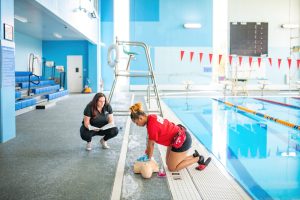Peace of mind is paramount for both aquatic facility owners and patrons. While it may be easy for patrons to enjoy a refreshing dip, ensuring everyone’s safety is more challenging. Creating a Safety Plan may assist in keeping your facility safe and open for patrons to continue to enjoy your facility. The Model Aquatic Health Code (MAHC) provides the framework for fostering a welcoming environment where everyone can enjoy the water with confidence.
The Five Pillars of a Safety Plan
The MAHC offers a powerful foundation for safeguarding your aquatic facility through five key pillars. The first, a Safety Plan, establishes a safety team with designated roles. This team undertakes tasks like hazard identification, enforcing rules, emergency response, and maintaining water quality.
An Emergency Action Plan (EAP) prepares your staff for unforeseen events. This plan outlines steps for drownings, medical emergencies, and environmental hazards. It ensures clear communication with responders and patrons, assigns responsibilities, and detailed evacuation procedures.
The Biohazard Action Plan addresses the specific protocols for handling blood, vomit, or other biohazards that may contaminate surfaces or the water.
Before assuming their duties, staff should ensure training as outlined in a Pre-Service Training Plan. This plan includes facility specific policies, emergency procedures, and essential skills like First Aid/CPR/AED.
Finally, the In-service Training Plan ensures staff maintain their knowledge and preparedness through ongoing training. This plan includes First Aid/CPR/AED, scenario-based drills to practice emergency response, and updates on relevant regulations.
Developing Your Safety Plan
Building Your Safety Team: A Staffing Plan for Aquatic Facilities
The heart of any safety plan is a well-defined staffing structure. First, identify your safety team members and assign clear roles. Who will be responsible for spotting hazards, enforcing rules, and responding to emergencies? Additionally, ensure someone is designated to maintain pristine water quality.

Now, for facilities with lifeguards, an extra layer of planning is crucial. Develop a detailed diagram that divides your aquatic venue into zones for patron surveillance. This ensures each area is constantly monitored by a lifeguard. Don't forget to establish rotation procedures! Regularly switching zones combats fatigue and keeps lifeguards alert, maximizing safety for your patrons.
Be Prepared: Crafting Your Emergency Action Plan
Imagine a situation – a medical emergency, a slip and fall, or even a sudden storm. Your Emergency Action Plan (EAP) is your roadmap for navigating these unforeseen events.
First, identify all potential emergencies, including imminent health hazards. Next, establish clear communication protocols. How will responders, emergency services, and patrons be informed? Assign roles with specific tasks and required equipment for each responder. Don't forget clear procedures for emergency closures.
For facilities with lifeguards, the EAP goes a step further. Detail how additional staff will be mobilized to assist the initial rescuer during an emergency. Swift action is crucial, and a well-defined plan ensures a coordinated response to keep everyone safe.
Addressing Biohazards: Your Biohazard Action Plan
Even the most sparkling aquatic facility can encounter biohazards like blood, vomit, or fecal contamination. A Biohazard Action Plan equips your staff to handle these situations effectively.
This plan outlines specific procedures for responding to biohazard contamination. It details disinfection protocols to ensure proper sanitation of the affected area and surrounding surfaces. The plan should also address the safe and appropriate disposal of contaminated materials. By following these steps, you can minimize health risks and maintain a hygienic environment for your patrons.
Equipping Your Team: Pre-Service and In-Service Training Plans
Before diving into their duties, your safety team needs a solid foundation of knowledge and skills. The Pre-Service Training Plan equips them for success. All team members will receive training on facility-specific policies, the Emergency Action Plan (EAP), and emergency closure procedures. They'll also learn proper biohazard response techniques as outlined in MAHC 6.5. This training includes practicing the EAP and demonstrating essential skills like CPR/AED. All training is documented for future reference.
For facilities with lifeguards, pre-service training goes a step further. Lifeguards will be trained on zone of patron surveillance plans, rotation plans, minimum staffing protocols, and comprehensive rescue/first aid response plans. They'll demonstrate their ability to reach the maximum water depth, identify victims in their assigned zones, and execute water rescues with proficiency.

But training doesn't stop there. The In-Service Training Plan ensures your team stays sharp. Schedule ongoing training sessions that cover CPR/AED renewal, scenario-based drills to practice emergency response under pressure, and updates on relevant regulations and best practices. Detailed records of these sessions, including attendees, content, date, and trainer information, are vital for maintaining compliance and a culture of safety awareness.
Keeping Your Plan Afloat: Maintaining Your Safety Plan
A safety plan isn't a static document. Schedule regular reviews to ensure they reflect any changes in regulations, staffing, or your facility layout. Practice drills for various emergency scenarios are essential. These drills keep your staff familiar with procedures, allowing them to react calmly and effectively in a real emergency.
Don't forget accessibility! Display your safety plan and EAP prominently for easy reference by all staff members. By keeping your plan current, practicing procedures, and ensuring easy access, you empower your team to prioritize safety at all times.
Conclusion: Building a Culture of Safety
Creating a safety plan using the framework provided by the MAHC is more than just following Industry Best Practices – it’s a powerful commitment to your patron’s well-being. By following the MAHC, you’ll establish a robust system to assist in preventing emergencies and ensure a swift, effective response if they occur. Regular reviews, training drills, and readily accessible plans empower frontline staff to act confidently. Remember, a well-executed safety plan goes beyond protocols; it fosters a culture of safety where everyone at your aquatic facility can relax and enjoy the water with peace of mind.
Johnathan Nies has a diverse aquatics background, including indoor and outdoor operations, training and management, and working for the National Swimming Pool Foundation. Johnathan learned pool operation and management by working with the City of Colorado Springs, the US Air Force Academy, and private clubs. After his time in aquatic operations, he helped launch the Advanced Service Technician course at the National Swimming Pool Foundation, which trains residential service professionals how to manage their business better and give the best service to their customers.
As a member of the CHAMP team, Johnathan maintains certifications as a Certified Park and Recreation Professional, Emergency Medical Technician, American Red Cross Lifeguard Instructor Trainer, Water Safety Instructor, and NSPF Certified Pool Operator.
